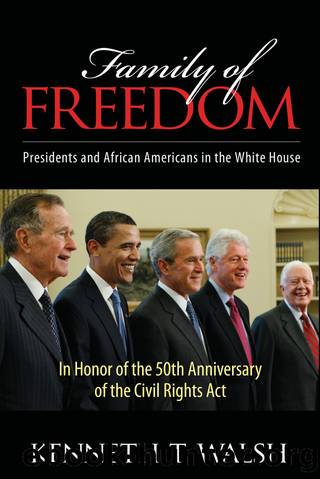Family of Freedom: Presidents and African Americans in the White House by Kenneth T. Walsh

Author:Kenneth T. Walsh [Walsh, Kenneth T.]
Language: eng
Format: epub
Tags: Political Science, General
ISBN: 9781317259640
Google: hNbOCgAAQBAJ
Goodreads: 27435509
Publisher: Routledge
Published: 2011-01-01T00:00:00+00:00
CHAPTER TEN
MIXED RESULTS IN A CONSERVATIVE ERA
Richard Nixon
The years from 1968 to 1992 marked what many black leaders considered a series of setbacks for civil rights and for race relations.1 Many white Americans felt that their own advancement was being hindered by government programs for blacks enacted under Lyndon Johnson. The assassinations of Martin Luther King Jr. and Robert Kennedy in 1968 demonstrated a virulent streak of anger and hatred permeating American life. Race riots underscored and intensified the polarization. The election of Republican Richard Nixon in 1968, based on his Southern strategy and a âlaw and orderâ message that divided whites from blacks, set the stage for more racial hostility and opened a particularly wide gap between working-class white America and black America.
Nixon had never associated much with blacks and largely avoided racial issues for most of his political career as a U.S. representative, U.S. senator, and vice president.2 But that changed in his 1968 campaign for president when he developed a âSouthern strategyâ of siding with conservative whites on a broad swath of issues that pitted them against blacks, including tough stands on crime and public demonstrations and an implicit commitment to slow down civil rights enforcement. This was designed to divide America, play upon white fears and resentments, and forge a new political majority based on bringing to the GOP as many previously Democratic white voters as possible.
In his losing campaign against John F. Kennedy in 1960, Nixon had carried 32 percent of the African American vote. But in the 1968 campaign, his approach to racial issues hardened, and his support among blacks plunged to 12 percent.3 At first, he positioned himself as a centrist alternative to the more liberal Nelson A. Rockefeller and the more conservative Ronald Reagan, two of his main competitors for the Republican nomination.4 But he moved decisively toward the conservative side and toward racial polarization when he convinced Southern delegates that he would be less aggressive in enforcing civil rights measures than would Rockefeller or the Democrats. In exchange for the support of leaders such as Senator Strom Thurmond of South Carolina, Nixon signaled that he would appoint more conservative judges and slow down school desegregation.
However, political scientist Alvin Felzenberg points out that, âAmong the ironies of Nixonâs presidency was that it was he who officiated over the final dismantling of segregation in the American south. Early in his administration, Nixon set out to achieve full implementation of the Brown v. Board of Education decision. Working through Secretary of Labor George P. Shultz, Nixonâs advisers set up biracial panels in each affected state to devise and implement plans to desegregate. In public, Nixon generally shied away from taking credit for his achievement. In private, and occasionally in public, he signaled to his southern supporters that the cost of their non-cooperation would entail more court orders, which he would enforce.â5
Political scientists Hanes Walton Jr. and Robert C. Smith agree, noting that, âAlthough Richard Nixon was a white supremacist and his 1968 campaign was
Download
This site does not store any files on its server. We only index and link to content provided by other sites. Please contact the content providers to delete copyright contents if any and email us, we'll remove relevant links or contents immediately.
| Africa | Americas |
| Arctic & Antarctica | Asia |
| Australia & Oceania | Europe |
| Middle East | Russia |
| United States | World |
| Ancient Civilizations | Military |
| Historical Study & Educational Resources |
Machine Learning at Scale with H2O by Gregory Keys | David Whiting(4183)
Never by Ken Follett(3793)
Fairy Tale by Stephen King(3220)
The Man Who Died Twice by Richard Osman(2997)
Oathbringer (The Stormlight Archive, Book 3) by Brandon Sanderson(2885)
Will by Will Smith(2793)
Rationality by Steven Pinker(2291)
The Dark Hours by Michael Connelly(2244)
Can't Hurt Me: Master Your Mind and Defy the Odds - Clean Edition by David Goggins(2228)
The Dawn of Everything: A New History of Humanity by David Graeber & David Wengrow(2122)
Friends, Lovers, and the Big Terrible Thing by Matthew Perry(2119)
Principles for Dealing With the Changing World Order: Why Nations Succeed and Fail by Ray Dalio(1974)
HBR's 10 Must Reads 2022 by Harvard Business Review(1777)
A Short History of War by Jeremy Black(1762)
Go Tell the Bees That I Am Gone by Diana Gabaldon(1687)
515945210 by Unknown(1599)
A Game of Thrones (The Illustrated Edition) by George R. R. Martin(1589)
Kingdom of Ash by Maas Sarah J(1526)
443319537 by Unknown(1470)
